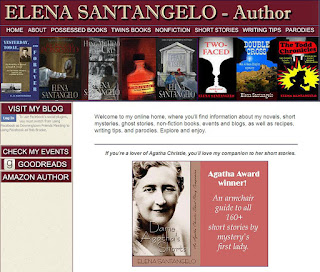 In today’s high-tech world, a writer’s presence online is the key that can potentially unlock publishing opportunities. And although it’s not an end in itself, it’s not only a start but the keystone in creating your online persona.
In today’s high-tech world, a writer’s presence online is the key that can potentially unlock publishing opportunities. And although it’s not an end in itself, it’s not only a start but the keystone in creating your online persona.Your Web site will be a resource for your readers and the media that’s available at any time. Through it you’ll be able to showcase your work and the writing services you have to offer. Sounds great, huh? Unfortunately, too great.
As you use the Internet each day, you come upon and use a variety of Web sites, all with slick layout and striking images. So naturally when you imagine a Web site for yourself, you visualize one like those you see every day. What you don’t realize is that many of the sites on the Web have been designed by professional Web designers. Normally, sites like these can cost a $1,500 or much more to create, depending on the site’s complexity.
But that doesn’t mean you can’t have a site that reflects your style and shows off your writing to your advantage. Since you probably don’t have a lot of money to spend on your site, you have two options—using one of the free Web site services or building your site yourself.
Before you can think about building a Web site, you’ll need to purchase a domain name, the Web address of your site. What you choose for your domain name is important, as it will guide visitors to your site. As a writer whose name is associated with your product, it’s important that it contain your name. Also, you should purchase a .com address since that’s the most common and the one that most visitors will search for. However, if the .com version of your URL is already taken, you might consider adding the word “writer” after your name. As with Email addresses, any little change, even a number, will enable you to purchase the .com URL. Avoid buying the .net and .org extensions of your URL. Sellers tell you that if you don’t, someone could use your name and take away potential visitors from your site. Since your URL features your name, that’s unlikely, unless if very common.
Your domain name should cost no more than $20 a year. It’s registered with ICANN, the international organization that controls Web addresses. Once you purchase it, no one else can use it. You will have to renew it every year or for multiple years, but if you purchase it along with hosting services, you’ll usually get it for a substantial discount.
After purchasing a domain name, you’ll need to find a host for your site. GoDaddy.com is one of the largest and most dependable Web hosts. Don’t let the name fool you. The company offers all sorts of Web products and provides excellent service, as well as guaranteed uptime. An economy Windows-based site with 10 GB of space (more than you’ll ever need) costs about $7 a month. And the company periodically offers generous discounts.
If you’re not yet published, then you should consider one of the free hosting plans available on the Web. These free sites use shared URLs, so you won’t be able to use your own domain name. Instead, your name will become part of the host’s domain name. However, a free site will give you the opportunity to try out your Web content. Unfortunately, all free Web services aren’t created equal. All use templates to create pages, but not all make it easy to transition to a paid site when you’re ready.
One of the most popular free services is Blogger, run by Google. Another is WordPress. Both were developed to service bloggers. Every single screen on the Internet is a Web page. An entire site is also referred to as a Web page. It’s a bit confusing. So if you start out doing a blog, you could potentially turn it into a site. GoDaddy includes WordPress as a product within its hosting package, so all you’d have to do is transfer the hosting to GoDaddy from the WordPress site. Blogger, on the other hand, cannot be transferred. Also, with free site services, you won’t be able to access Web site traffic statistics in order to see what’s working or not on your site.
However, don’t think because you have a free hosted site that no one will find you. If you promote your URL enough—even a shared one—they will. In the case of Web sites, patience is definitely a virtue.
The other option is to create your site from scratch without templates. While there are Web design programs available, all demand at least a basic level of computer expertise to fully customize your site—to decide fonts, colors, and layout. Customizing your site is critical for your long-term career planning. That leaves you in a catch-22 situation.
A compromise would be to sign up for GoDaddy’s “Web Site Tonight” package. You’ll pay a hosting fee, but you’ll also get templates to use to build your site. The service is limiting, however, and cannot be transferred to a regular hosting package. You’d have to begin all over again without the templates. But you may be able to create a business-like site if you use the templates and such wisely. Don’t kid yourself. It will never look like the slick sites you use every day.
Next Week: Designing Your Web Site
na.


